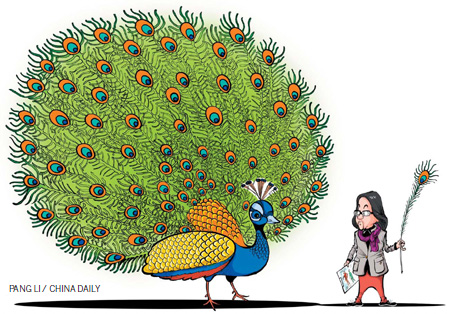Economy
Schools important part of fashion trends
Updated: 2011-06-17 14:15
(China Daily European Weekly)
|
 |
China has long been known as the "king of apparel production" across the world. But it has learned from the past to make progress in today's apparel industry.
Fashion schools have played an important role in that progression. This specific type of education is relatively new in China and follows the same path as modern higher education. They are a result of the developments in the West.
China is embarking on a splendid apparel voyage. Not only do we inherit and develop traditions, but we also follow and integrate ideas into current fashion trends.
These characteristics have undoubtedly become the main theme of Chinese higher education of apparel and also imposed pressures on its future development.
Higher education in fashion began about 30 years ago. In the early stages, Chinese fashion designs were moving ahead without enough experience, necessary textbooks, teachers or equipment.
At that time, as a subject, apparel was still isolated from tradition and designers lacked an understanding of its importance in society. Higher education mixed in a variety of subjects to teach apparel design, which was based on the experiences in the West. It was also a response to meet the demand of the industry.
In the current environment of globalization, Chinese apparel education has focused on market practicability and innovative fashion, and gradually entered into the world of fashion design education trends with a professional attitude.
What is noticeable is that, with the integration of many countries and their economies, Chinese higher education is becoming more international. This puts forward new requirements for the cultivation of design talents.
There are two special features that will be required when instructing new design students.
First, Chinese universities must pay particular attention to market demand. Schools are putting more emphasis on the relationships between classroom lessons and the economy and technology.
Schools should explore new models of collaboration between universities and apparel companies when instructing young designers. Universities are in charge of their fundamental training, while apparel companies giveopportunities for designers to enter the market.
To help train the students for the real world, some universities have plans to build design studios, which would be supervised by teachers and used by senior students. These studios would have direct interaction with consumers.
Universities should also encourage students to take part-time jobs at apparel companies, which would help them obtain internships.
Second, universities are gradually emerging as a platform for international communication, and should start to actively seek international cooperation in design education and brand building. Meanwhile, they should also strengthen collaboration with foreign institutions in joint education and enhance the internationalization of apparel talents.
As an applied subject, modern apparel is not only a practical subject, but also a subject that draws from science, art and culture.
Therefore, to further develop higher education courses, we should continue to strengthen the interdisciplinary studies of textile engineering, fashion and art; implement joint research; and insist on the combination of science, art and fashion.
Science describes the application and innovation of modern science and technology in the apparel industry. Art includes the reflection of the current world art trends, and also includes incorporating traditional arts based on thenationalculture. Fashion means the current trends, but also working with the contemporary Chinese culture.
As the economy grows,the Chineseapparel industry is playing an increasinglyimportant rolein the fashion industry. The current favorable environment of the Chinese apparel industry also gives talented Chinese designers more opportunities. All of the elements working together create a great outlook for the Chinese apparel industry.
The future of the Chinese apparel market will become more segmented, meaning more options for consumers.
Because of this, it is also important to change the concept of how clothes are produced, enhancing the process from manufacturers to consumers.
Each brand will target specific consumers as companies develop multiple fashion lines, which is also the general direction ofproduction development.
This requiresdesignersto have a clear vision of who they are designing for, including age, gender, andoccasions. It also promptsdesignerstoconcentrate on a certain expertise and master as much knowledge as possible from the process of productioncontrol, marketing, media campaign, store decoration, displayand otherrelated areas.
However, wemust be awarethat ifChina'snew generationof contemporary fashion designers wantto succeed, they should take the initiativeto strengthentheir understanding ofthe fashionindustry andcontemporaryChinese society andculture. Learning how all of these things work together is averyimportant concept for young designers, because it is their responsibilityand obligation to society, and the only way to succeed.
For these reasons, Chinese fashion institutions should create curriculums that transition China from "king of apparel production" to "king of designer apparel", or even to a country to be known as a country with an influential culture. They should also shoulder more responsibilities in terms of talent training, innovation, social services and cultural inheritance.
Apparel is not only a culture but also a symbol of civilization.In the context of economic development and social progress, Chinese fashion design concepts will be constantly updated, bridging the gap between China and the world. Chinese designers will also gradually realize the value of their national culture and use their moderntastes and unique self-awareness to inherit, innovate and promote national culture, pave their own roads and create designs with Chinese style.
We should consciously keep Chinese traditional culture and social reality in mind, pay more attention to local consumers' needs and develop our own distinctive cultural characteristics.
The author is president of Beijing Institute of Fashion Technology.

Specials

Mom’s the word
Italian expat struggles with learning English and experiences the joys of motherhood again.

Big win
After winning her first major title, Chinese tennis star could be marketing ace for foreign brands

Markers of memories
Axe comes down on historical buildings as part of Harbin government’s baroque programs